Innovative Technologies for Occupational Health and Safety: A Scoping Review
Abstract
1. Introduction
2. Materials and Methods
3. Results
3.1. Occupational Safety Technologies
3.1.1. Portable Devices for Occupational Safety
3.1.2. Robots and Drones for Occupational Safety
3.1.3. Occupational Security Applications
3.1.4. Virtual, Augmented, and Mixed Reality for Occupational Safety
3.1.5. New Materials for Occupational Safety
3.2. Occupational Health Technologies
3.2.1. Portable Devices for Occupational Health
3.2.2. Robots and Drones
3.2.3. Health Applications
3.2.4. Virtual, Augmented, and Mixed Reality
4. Discussion
5. Conclusions
Author Contributions
Funding
Data Availability Statement
Conflicts of Interest
Appendix A
| SECTION | ITEM | PRISMA-ScR CHECKLIST ITEM | REPORTED ON PAGE |
|---|---|---|---|
| TITLE | |||
| Title | 1 | Identify the report as a scoping review. | 1 |
| ABSTRACT | |||
| Structured summary | 2 | Provide a structured summary that includes (as applicable): background, objectives, eligibility criteria, sources of evidence, charting methods, results, and conclusions that relate to the review questions and objectives. | 1 |
| INTRODUCTION | |||
| Rationale | 3 | Describe the rationale for the review in the context of what is already known. Explain why the review questions/objectives lend themselves to a scoping review approach. | 2 |
| Objectives | 4 | Provide an explicit statement of the questions and objectives being addressed with reference to their key elements (e.g., population or participants, concepts, and context) or other relevant key elements used to conceptualize the review questions and/or objectives. | 2 |
| METHODS | |||
| Protocol and registration | 5 | Indicate whether a review protocol exists; state if and where it can be accessed (e.g., a Web address); and if available, provide registration information, including the registration number. | 2–4 |
| Eligibility criteria | 6 | Specify characteristics of the sources of evidence used as eligibility criteria (e.g., years considered, language, and publication status), and provide a rationale. | 4 |
| Information sources | 7 | Describe all information sources in the search (e.g., databases with dates of coverage and contact with authors to identify additional sources), as well as the date the most recent search was executed. | 4 |
| Search | 8 | Present the full electronic search strategy for at least one database, including any limits used, such that it could be repeated. | 4 |
| Selection of sources of evidence | 9 | State the process for selecting sources of evidence (i.e., screening and eligibility) included in the scoping review. | 4 |
| Data charting process | 10 | Describe the methods of charting data from the included sources of evidence (e.g., calibrated forms or forms that have been tested by the team before their use, and whether data charting was done independently or in duplicate) and any processes for obtaining and confirming data from investigators. | 4 |
| Data items | 11 | List and define all variables for which data were sought and any assumptions and simplifications made. | 4 |
| Critical appraisal of individual sources of evidence | 12 | If done, provide a rationale for conducting a critical appraisal of included sources of evidence; describe the methods used and how this information was used in any data synthesis (if appropriate). | 4 |
| Synthesis of results | 13 | Describe the methods of handling and summarizing the data that were charted. | 4 |
| RESULTS | |||
| Selection of sources of evidence | 14 | Give numbers of sources of evidence screened, assessed for eligibility, and included in the review, with reasons for exclusions at each stage, ideally using a flow diagram. | 4–14 |
| Characteristics of sources of evidence | 15 | For each source of evidence, present characteristics for which data were charted and provide the citations. | 4–14 |
| Critical appraisal within sources of evidence | 16 | If done, present data on critical appraisal of included sources of evidence (see item 12). | 4–14 |
| Results of individual sources of evidence | 17 | For each included source of evidence, present the relevant data that were charted that relate to the review questions and objectives. | 4–14 |
| Synthesis of results | 18 | Summarize and/or present the charting results as they relate to the review questions and objectives. | 4–14 |
| DISCUSSION | |||
| Summary of evidence | 19 | Summarize the main results (including an overview of concepts, themes, and types of evidence available), link to the review questions and objectives, and consider the relevance to key groups. | 14 |
| Limitations | 20 | Discuss the limitations of the scoping review process. | 15 |
| Conclusions | 21 | Provide a general interpretation of the results with respect to the review questions and objectives, as well as potential implications and/or next steps. | 15 |
| FUNDING | |||
| Funding | 22 | Describe sources of funding for the included sources of evidence, as well as sources of funding for the scoping review. Describe the role of the funders of the scoping review. | 16 |
References
- Tarique, I.; Briscoe, D.R.; Schuler, R.S. International Human Resource Management: Policies and Practices for Multinational Enterprises, 6th ed.; Routledge: London, UK, 2022. [Google Scholar] [CrossRef]
- Kim, J.; Kim, N.; Kwon, M.; Lee, J. Attachable Pulse Sensors Integrated with Inorganic Optoelectronic Devices for Monitoring Heart Rates at Various Body Locations. ACS Appl. Mater. Interfaces 2017, 9, 25700–25705. [Google Scholar] [CrossRef]
- Ometov, A.; Shubina, V.; Klus, L.; Skibińska, J.; Saafi, S.; Pascacio, P.; Flueratoru, L.; Gaibor, D.Q.; Chukhno, N.; Chukhno, O.; et al. A Survey of Wearable Technology: History, State of the Art, and Current Challenges. Comput. Netw. 2021, 193, 108074. [Google Scholar] [CrossRef]
- Mohammed, J.; Mahmud, J. Selection of a machine learning algorithm for OSHA fatalities. In Proceedings of the 2020 IEEE Technology & Engineering Management Conference (TEMSCON), Novi, MI, USA, 3–6 June 2020. [Google Scholar]
- Kelm, A.; Meins-Becker, A.; Helmus, M. Improving Occupational Health and Safety by Using Advanced Technologies and BIM. In Proceedings of the International Structural Engineering and Construction, Chicago, IL, USA, 20–25 May 2019. [Google Scholar] [CrossRef]
- PRISMA Statement. PRISMA for Scoping Reviews. 2021. Available online: http://www.prisma-statement.org/Extensions/ScopingReviews (accessed on 12 May 2023).
- Flor, O.; Acosta-Vargas, P. (Dataset) Innovative Technologies for Safety and Health Occupational. Mendeley Data, V1. 2023. Available online: https://data.mendeley.com/datasets/gsm53nrgvb/1 (accessed on 18 April 2023). [CrossRef]
- Eriksen, M.B.; Frandsen, T.F. The impact of patient, intervention, comparison, outcome (PICO) as a search strategy tool on literature search quality: A systematic review. J. Med. Libr. Assoc. 2018, 106, 420–431. [Google Scholar] [CrossRef]
- Choi, B.; Hwang, S.; Lee, S. What drives construction workers’ acceptance of wearable technologies in the workplace? Indoor localization and wearable health devices for occupational safety and health. Autom. Constr. 2017, 84, 31–41. [Google Scholar] [CrossRef]
- Bastani, K.; Kim, S.; Kong, Z.; Nussbaum, M.A.; Huang, W. Online classification and sensor selection optimization with applications to human material handling tasks using wearable sensing technologies. Biomechatronics 2016, 46, 485–497. [Google Scholar] [CrossRef]
- Rajendran, S.; Giridhar, S.; Chaudhari, S.; Gupta, P.K. Technological advancements in occupational health and safety. Meas. Sens. 2021, 15, 100045. [Google Scholar] [CrossRef]
- Chihming, W.; Zexin, J.; Songqing, H.; Zhongwei, Y. Investigation on the Eye-tracking Technology in Hazard Identification of Building Construction Engineering. In Proceedings of the 2nd IEEE International Conference on Architecture, Construction, Environment and Hydraulics, Hsinchu, Taiwan, 25–27 December 2020. [Google Scholar]
- Tamers, S.L.; Streit, J.; Pana-Cryan, R.; Ray, T.; Syron, L.; Flynn, M.A.; Castillo, D.; Roth, G.; Geraci, C.; Guerin, R.; et al. Envisioning the future of work to safeguard the safety, health, and well-being of the workforce: A perspective from the CDC’s National Institute for Occupational Safety and Health. Am. J. Ind. Med. 2020, 63, 1065–1084. [Google Scholar] [CrossRef] [PubMed]
- Schall, M.; Sesek, R.; Cavuoto, L. Barriers to the Adoption of Wearable Sensors in the Workplace: A Survey of Occupational Safety and Health Professionals. Hum. Factors 2018, 60, 351–362. [Google Scholar] [CrossRef] [PubMed]
- Kim, Y.; Yun, J.; Oh, T. Effectiveness Analysis for Smart Construction Safety Technology (SCST) by Test Bed Operation on Small- and Medium-Sized Construction Sites. Environ. Res. Public Health 2022, 19, 5203. [Google Scholar] [CrossRef]
- Hemavani, K.; Kumar, V. Temperature Programmable Suit using Thermoelectric Cooler/Heater. SSRG Int. J. Electron. Commun. Eng. 2015, 2, 7. [Google Scholar]
- Álvarez, E.; Cubero-Atieza, A.; Ruiz-Martinez, P.; Vaquero-Abellán, M.; Redel, M.; Aparicio-Martinez, P. Bibliometric Study of Technology and Occupational Health in Healthcare Sector: A Worldwide Trend to the Future. Environ. Res. Public Health 2020, 17, 6732. [Google Scholar] [CrossRef] [PubMed]
- Hwang, S.; Lee, S. Wristband-type wearable health devices to measure construction workers’ physical demands. Automat. Constr. 2017, 83, 330–340. [Google Scholar] [CrossRef]
- Nakanishi, M.; Taguchi, K.-I.; Okada, Y. Suggestions on the applicability of visual instructions with see-through head mounted displays depending on the task. Appl. Ergon. 2010, 42, 146–155. [Google Scholar] [CrossRef] [PubMed]
- Sadeghi, S.; Soltanmohammadlou, N.; Nasirzadeh, F. Applications of wireless sensor networks to improve occupational safety and health in underground mines. J. Saf. Res. 2021, 83, 8–25. [Google Scholar] [CrossRef]
- Niehaus, S.; Hartwig, M.; Rosen, P.H.; Wischniewski, S. An Occupational Safety and Health Perspective on Human in Control and AI. Front. Artif. Intell. 2022, 8, 868382. [Google Scholar] [CrossRef]
- Zhang, M.; Ghodrati, N.; Poshdar, M.; Seet, B.; Yongchareon, S. A construction accident prevention system based on the Internet of Things (IoT). Saf. Sci. 2023, 159, 106012. [Google Scholar] [CrossRef]
- Tender, M.; Fuller, P.; Vaughan, A.; Long, M.; Couto, J.; Damien, P.; Chow, V.; Silva, F.; Reis, F.; Reis, R. Lessons from implementation of Key Technological Developments to improve occupational safety and health processes in a complex UK-based construction project. IOP Conf. Ser. Earth Environ. Sci. 2022, 1101, 092016. [Google Scholar] [CrossRef]
- Alsadik, B.; Khalaf, Y.H. Potential Use of Drone Ultra-High-Definition Videos for Detailed 3D City Modeling. ISPRS Int. J. Geo-Inf. 2022, 11, 34. [Google Scholar] [CrossRef]
- Duraisamy, J. Design and Analysis of Remotely Amphibious Drone. Int. J. Innov. Technol. Explor. Eng. 2020, 9, 284–287. [Google Scholar]
- Johnsen, S.; Bakken, T.; Transeth, A.; Holmstrøm, S.; Merz, M.; Grøtli., E.I.; Jacobsen, S.R.; Storvold, R. Safety and security of drones in the oil and gas industry. In Proceedings of the 30th European Safety and Reliability Conference and the 15th Probabilistic Safety Assessment and Management Conference, Venice, Italy, 1–5 November 2020. [Google Scholar]
- De Fazio, R.; Dinoi, L.M.; De Vittorio, M.; Visconti, P. A Sensor-Based Drone for Pollutants Detection in Eco-Friendly Cities: Hardware Design and Data Analysis Application. Electronics 2022, 11, 52. [Google Scholar] [CrossRef]
- Khalid, M.; Knightly, E. Networked Drones for Industrial Emergency Events. Syst. Control 2022. [Google Scholar] [CrossRef]
- Nooralishahi, P.; Ibarra-Castanedo, C.; Deane, S.; López, F.; Pant, S.; Genest, M.; Avdelidis, N.P.; Maldague, X.P.V. Drone-Based Non-Destructive Inspection of Industrial Sites: A Review and Case Studies. Drones 2021, 5, 106. [Google Scholar] [CrossRef]
- Liu, P.; Chen, A.Y.; Huang, Y.N.; Han, J.Y.; Lai, J.S.; Kang, S.C.; Wu, T.H.; Wen, M.C.; Tsai, M.H. A review of rotorcraft unmanned aerial vehicle (UAV) developments and applications in civil engineering. Smart Struct. Syst. 2014, 13, 1065–1094. [Google Scholar] [CrossRef]
- Masoud, G.; Esmaeili, B. Unmanned Aerial Systems (UAS) for Construction Safety Applications. In Proceedings of the 2016 Construction Research Congress, San Juan, Puerto Rico, 31 May–2 June 2016; pp. 2642–2650. [Google Scholar] [CrossRef]
- Kinaneva, D.; Hristov, G.; Raychev, J.; Zahariev, P. Early Forest Fire Detection Using Drones and Artificial Intelligence. In Proceedings of the 2019 42nd International Convention on Information and Communication Technology, Electronics and Microelectronics (MIPRO), Opatija, Croatia, 20–24 May 2019; pp. 1060–1065. [Google Scholar]
- Poy, H.M.; Duffy, B. A Cloud-Enabled Building and Fire Emergency Evacuation Application. IEEE Cloud Comput. 2014, 1, 40–49. [Google Scholar] [CrossRef]
- Thygerson, S.; West, J.; Rassbach, A.; Thygerson, A. iPhone Apps for First Aid: A Content Analysis. J. Consum. Health Internet 2012, 16, 213–225. [Google Scholar] [CrossRef]
- Pattaraporn, K.; Benjamas, S.; Orawit, T. First Aid Literacy Mobile Application Development. In Proceedings of the 8th International Conference on Information Communication and Management (ICICM ‘18), Shenyang, China, 10–12 August 2018; Association for Computing Machinery: New York, NY, USA, 2018; pp. 17–21. [Google Scholar]
- Spies, C.; Khalaf, A.; Hamam, Y. Development of a first aid smartphone app for use by untrained healthcare workers. Afr. J. Inf. Commun. 2017, 20, 31–47. [Google Scholar]
- Dhayaneshwar, K.; Karthik, M.; Sharmila, B. Complete First Aid App. Int. J. Trendy Res. Eng. Technol. (IJTRET) 2017, 1, 3. [Google Scholar]
- Kilshaw, A.; Jivan, S. Smartphone apps on burns first aid: A review of the advice. Burns 2021, 47, 171–174. [Google Scholar] [CrossRef]
- Zsofkovits, M.; Cheng, S.; Walder, F.; Heidenberger, K. Smartphone-Based Coordination Support for the Austrian Medical First Responder System. In Proceedings of the Third International Conference on Emerging Intelligent Data and Web Technologies, Bucharest, Romania, 19–21 September 2012. [Google Scholar]
- Dillane, D.; Jo Anne, G. Comparison between OSHA-NIOSH Heat Safety Tool app and WBGT monitor to assess heat stress risk in agriculture. J. Occup. Environ. Hyg. 2020, 78, 181–192. [Google Scholar] [CrossRef]
- Park, H.; Kim, K.; Ghung, H.; Jeong, S.; Soh, J.; Hyun, Y.; Kim, H. A Worker-Centered Personal Health Record App for Workplace Health Promotion Using National Health Care Data Sets: Design and Development Study. JMIR Public Health Surveill. 2021, 9, e29184. [Google Scholar] [CrossRef]
- Papathoma-Koehle, M.; Promper, C.; Bojariu, R.; Cica, R.; Sik, A.; Perge, K.; László, P.; Czikora, E.B.; Dumitrescu, A.; Turcus, C.; et al. A common methodology for risk assessment and mapping for south-east Europe: An application for heat wave risk in Romania. Nat. Hazards 2016, 82, 89–109. [Google Scholar] [CrossRef]
- Ariza, A.; Baltao, J. Ergonomic evaluation and design of a mobile application for maternal and infant health for smartphone users among lower-income class Filipinos. In Proceedings of the 6th International Conference on Applied Human Factors and Ergonomics (AHFE 2015) and the Affiliated Conferences, AHFE, Vegas, NV, USA, 26–30 July 2015; Volume 3. [Google Scholar]
- Araguillin, J.X.; Escarabay, K.E.; Trujillo, M.F.; Rosales, A. Mobile Application for Ergonomic Analysis of the Sitting Posture of the Torso. In Proceedings of the International Conference on Information Systems and Computer Science (INCISCOS), Quito, Ecuador, 13–15 November 2018; pp. 42–48. [Google Scholar]
- Gan, Y.; Liu, S.; Zhu, W. Studies and Application of Heavy Equipment Fault Diagnosis System. Adv. Mater. Res. 2011, 225, 399–402. [Google Scholar] [CrossRef]
- Wang, P.; Zhang, X.; Xing, S.; Liu, T.; Zhang, C. Development and application of lifting and leveling system for space station. J. Phys. Conf. Ser. 2019, 1314, 012092. [Google Scholar]
- Ricketts, M. Introduction to Sling Load Tension Calculations; Mitch Ricketts Northeastern State University: Broken Arrow, OK, USA, 2015. [Google Scholar]
- Jacobs, N.; Roberts, B.; Reamer, H.; Mathis, C.; Gaffney, S.; Neitzel, R. Noise exposures in different community settings measured by traditional dosimeter and smartphone app. Appl. Acoust. 2020, 167, 107408. [Google Scholar] [CrossRef]
- Gualandi, I.; Tessarolo, M.; Mariani, F.; Possanzini, L.; Scavetta, E.; Fraboni, B. Textile chemical sensors based on conductive polymers for the analysis of sweat. Polymers 2021, 13, 894. [Google Scholar] [CrossRef]
- Flores, E.; Da Silva, C. Innovation in the Workplace—Reinvigorating the Culture of Safety and Occupational Health: Contributions from a Literature Review. Eng. Sci. Technol. Int. J. 2017, 20, 372–380. [Google Scholar]
- Bottani, E.; Vignali, G. Augmented reality technology in the manufacturing industry: A review of the last decade. IISE Trans. 2019, 3, 284–310. [Google Scholar] [CrossRef]
- Valero, E.; Sivanathan, A.; Bosché, F.; Abdel-Wahab, M. Musculoskeletal disorders in construction: A review and a novel system for activity tracking with body area network. Appl. Ergon. 2016, 54, 120–130. [Google Scholar] [CrossRef]
- Ranjan, A.; Zhao, Y.; Misra, P. Opportunities and Challenges in Health Sensing for Extreme Industrial Environment: Perspectives from Underground Mines. IEEE Access 2016, 4, 139181–139195. [Google Scholar] [CrossRef]
- Nnaji, C.; Awolusi, I.; Park, J.W.; Albert, A. Wearable sensing devices: Towards the development of a personalized system for construction safety and health risk mitigation. Sensors 2021, 21, 682. [Google Scholar] [CrossRef]
- Xu, J.; Lu, W.; Wu, L.; Lou, J.; Li, X. Balancing privacy and occupational safety and health in construction: A blockchain-enabled P-OSH deployment framework. Saf. Sci. 2022, 154, 105860. [Google Scholar] [CrossRef]
- Yiqing, N.L. Virtual and augmented reality technologies for emergency management in the built environments: A state-of-the-art review. J. Saf. Sci. Resil. 2021, 2, 1–10. [Google Scholar]
- Nazir, S.; Manca, D. Immersive Virtual Reality for Training and Decision Making: Preliminary Results of Experiments Performed With a Plant Simulator. SPE Econ. Manag. 2014, 6, 165–172. [Google Scholar]
- Koźlak, M.; Kurzeja, A.; Nawrat, A. Virtual Reality Technology for Military and Industry Training Programs. In Vision Based Systems for UAV Applications. Studies in Computational Intelligence; Nawrat, A., Kuś, Z., Eds.; Springer: Berlin/Heidelberg, Germany, 2013; Volume 481. [Google Scholar] [CrossRef]
- Grabowski, A.; Jankowski, J. Virtual Reality-based pilot training for underground coal miners. Saf. Sci. 2015, 72, 310–314. [Google Scholar] [CrossRef]
- Zhao, D.; Lucas, J. Virtual reality simulation for construction safety promotion. Int. J. Inj. Control Saf. Promot. 2015, 22, 57–67. [Google Scholar] [CrossRef]
- Le, Q.; Pedro, A.; Park, C. A Social Virtual Reality-Based Construction Safety Education System for Experiential Learning. J. Intell. Robot. Syst. 2015, 79, 487–506. [Google Scholar] [CrossRef]
- Ahmad, Z.; Patle, D.; Rangaiah, G. Operator training simulator for biodiesel synthesis from waste cooking oil. Process Saf. Environ. Prot. 2016, 99, 55–68. [Google Scholar] [CrossRef]
- Wahidi, S.; Pribadi, T.; Rajasa, W.; Arif, M. Virtual Reality Based Application for Safety Training at Shipyards. IOP Conf. Ser. Earth Environ. Sci. 2022, 972, 012025. [Google Scholar] [CrossRef]
- Hoang, T.; Greuter, S.; Taylor, S.; Aranda, G.; Mulvany, G.T. An Evaluation of Virtual Reality for Fear Arousal Safety Training in the Construction Industry. In Proceedings of the 2021 IEEE International Symposium on Mixed and Augmented Reality Adjunct (ISMAR-Adjunct), Bari, Italy, 4–8 October 2021; pp. 177–182. [Google Scholar]
- Xu, Z.; Zheng, N. Incorporating Virtual Reality Technology in Safety Training Solution for Construction Site of Urban Cities. Sustainability 2020, 13, 243. [Google Scholar] [CrossRef]
- INSST. Seguridad y Salud en el Trabajo con Nanomateriales. Available online: https://www.insst.es/documents/94886/514312/poster+sst+nanomateriales.pdf/443eb879-268b-4263-83ae-1db72ca11ce9?t=1605801005033 (accessed on 10 January 2023).
- Cochrane, C.; Hertleer, C.; Schwarz-Pfeiffer, A. Smart Textiles and Their Applications; Woodhead Publishing Series in Textiles; Woodhead Publishing: Cambridge, UK, 2016; pp. 9–32. [Google Scholar]
- Jozef, S.; Ľudmila, B. Multifunctional fabric with Camouflage Print, Hydrophobic, Self-Cleaning and Antimicrobial Nanofinish. 2013. Available online: https://www.researchgate.net/publication/289041846_Multifunctional_fabric_with_camouflage_print_hydrophobic_self-cleaning_and_antimicrobial_nanofinish (accessed on 12 May 2023).
- Dhinakaran, V.; Gokhulabalan, B.; Rahul Kumar, A.; Ravichandran, M. Advancement in materials for industrial safety helmets. Mater. Today Proc. 2020, 27, 777–782. [Google Scholar] [CrossRef]
- Vukicevic, A.; Macužic, I.; Milicevic, V.; Shamina, L. Digital Training and Advanced Learning in Occupational Safety and Health Based on Modern and Affordable Technologies. Sustainability 2021, 13, 13641. [Google Scholar] [CrossRef]
- Chen, M.; Ma, Y.; Song, J.; Lai, C.-F.; Hu, B. Smart Clothing: Connecting Human with Clouds and Big Data for Sustainable Health Monitoring. Mob. Netw. Appl. 2016, 21, 825–845. [Google Scholar] [CrossRef]
- Simpson, L.; Maharaj, M.M.; Mobbs, R.J. The role of wearables in spinal posture analysis: A systematic review. BMC Musculoskelet. Disord. 2019, 20, 55. [Google Scholar] [CrossRef] [PubMed]
- Yang, L.; Lu, K.; Diaz-Olivares, J.A.; Seoane, F.; Lindecrantz, K.; Forsman, M.; Abtahi, F.; Eklund, J.A.E. Towards Smart Work Clothing for Automatic Risk Assessment of Physical Workload. IEEE Access 2018, 6, 40059–40072. [Google Scholar] [CrossRef]
- Yeung, S.S.Y.; Trappenburg, M.C.; Meskers, C.G.M.; Maier, A.B.; Reijnierse, E.M. The use of a portable metabolic monitoring device for measuring RMR in healthy adults. Br. J. Nutr. 2020, 124, 1229–1240. [Google Scholar] [CrossRef]
- Jebelli, H.; Choi, B.; Lee, S.H. Application of Wearable Biosensors to Construction Sites. I: Assessing Workers’ Stress. J. Biosens. Tech. 2019, 145, 12. [Google Scholar] [CrossRef]
- Hayden, M.; Barim, M.; Weaver, D.; Elliot, K.; Flynn, M.; Lincoln, J. Occupational Safety and Health with Technological Developments in Livestock Farms: A Literature Review. Int. J. Environ. Res. Public Health 2022, 19, 16440. [Google Scholar] [CrossRef]
- Hiebert, B.; Nouvet, E.; Jeyabalan, V.; Donelle, L. The Application of Drones in Healthcare and Health-Related Services in North America: A Scoping Review. Drones 2020, 4, 30. [Google Scholar] [CrossRef]
- Carrillo, R.; Moscoso, M.; Taype, A.; Ruiz, A.; Bernabe, A. The use of unmanned aerial vehicles for health purposes: A systematic review of experimental studies. Glob. Health Epidemiol. Genom. 2018, 3, e13. [Google Scholar] [CrossRef]
- Zwęgliński, T. The Use of Drones in Disaster Aerial Needs Reconnaissance and Damage Assessment—Three-Dimensional Modeling and Orthophoto Map Study. Sustainability 2020, 12, 6080. [Google Scholar] [CrossRef]
- Claesson, A.; Fredman, D.; Svensson, L.; Ringh, M.; Hollenberg, J.; Nordberg, P.; Rosenqvist, M.; Djarv, T.; Österberg, S.; Lennartsson, J.; et al. Unmanned aerial vehicles (drones) in out-of-hospital-cardiac arrest. Scand. J. Trauma Resusc. Emerg. Med. 2016, 24, 124. [Google Scholar] [CrossRef] [PubMed]
- Mayer, S.; Lischke, L.; Wozniak, P. Drones for Search and Rescue. In Proceedings of the iHDI—International Workshop on Human-Drone Interaction, Glasgow, UK, 5 May 2019. [Google Scholar]
- Riccò, M.; Ranzieri, S.; Vezzosi, L.; Balzarini, F.; Bragazzi, N.L. Wearable Exoskeletons on the Workplaces: Knowledge, Attitudes and Perspectives of Health and Safety Managers on the implementation of exoskeleton technology in Northern Italy. Acta Bio Med. Atenei Parm. 2021, 92, e2021310. [Google Scholar] [CrossRef]
- Fritzsche, L.; Galibarov, P.; Gärtner, C.; Bornmann, J.; Damsgaard, M.; Wall, R. Assessing the efficiency of exoskeletons in physical strain reduction by biomechanical simulation with AnyBody Modeling System. Wearable Technol. 2021, 2, e6. [Google Scholar] [CrossRef]
- Li, J.M.; Molinaro, D.D.; King, A.S.; Mazumdar, A.; Young, A.J. Young. Design and Validation of a Cable-Driven Asymmetric Back Exosuit. IEEE Trans. Robot. 2022, 38, 1489–1502. [Google Scholar] [CrossRef]
- Ferrone, A.; Napier, C.; Menon, C. Wearable technology to increase self-awareness of low back pain: A survey of technology needs among health care workers. Sensors 2021, 21, 8412. [Google Scholar] [CrossRef]
- Godoy, J.C.; Campos, I.J.; Pérez, L.M.; Muñoz, L.R. Nonanthropomorphic exoskeleton with legs based on eight-bar linkages. Int. J. Adv. Robot. Syst. 2018, 15. [Google Scholar] [CrossRef]
- Wang, Z.; Wu, X.; Zhang, Y.; Chen, C.; Liu, S.; Liu, Y.; Peng, A.; Ma, Y. A Semi-active Exoskeleton Based on EMGs Reduces Muscle Fatigue When Squatting. Front. Neurorobotics 2021, 15, 625479. [Google Scholar] [CrossRef]
- Khairul, A.; Adel, A. Active Exoskeleton Control Systems: State of the Art. Procedia Eng. 2022, 41, 988–994. [Google Scholar]
- Zhao, W.; Lun, R.; Gordon, C.; Fofana, A.B.; Espy, D.D.; Reinthal, M.A.; Ekelman, B.; Goodman, G.D.; Niederriter, J.E.; Luo, X. A Human-Centered Activity Tracking System: Toward a Healthier Workplace. IEEE Trans. Hum.-Mach. Syst. 2017, 47, 343–355. [Google Scholar] [CrossRef]
- Sun, C.; Buchholz, B.; Quinn, M.; Punnett, L.; Galligan, C.; Gore, R. Ergonomic evaluation of slide boards used by home care aides to assist client transfers. Ergonomics 2018, 61, 913–922. [Google Scholar] [CrossRef]
- Jebelli, H.; Hwang, S.; Lee, S. EEG-based workers’ stress recognition at construction sites. Autom. Constr. 2018, 93, 315–324. [Google Scholar] [CrossRef]
- Ulhaq, A.; Born, J.; Khan, A.; Gomes, D.P.S.; Chakraborty, S.; Paul, M. COVID-19 Control by Computer Vision Approaches: A Survey. IEEE Access 2020, 8, 179437–179456. [Google Scholar] [CrossRef] [PubMed]
- Petz, P.; Eibensteiner, F.; Langer, J. Sensor Shirt as Universal Platform for Real-Time Monitoring of Posture and Movements for Occupational Health and Ergonomics. Procedia Comput. Sci. 2021, 180, 200–207. [Google Scholar] [CrossRef]
- Granger, S.; Turner, N. Adapting, adopting, and advancing change: A framework for future research in the psychology of occupational safety. J. Saf. Res. 2022, 82, 38–47. [Google Scholar] [CrossRef] [PubMed]
- Chen, D.; Cai, Y.; Qian, X.; Ansari, R.; Xu, W.; Chu, K.C.; Huang, M.C. Bring Gait Lab to Everyday Life: Gait Analysis in Terms of Activities of Daily Living. IEEE Internet Things J. 2020, 7, 1298–1312. [Google Scholar] [CrossRef]
- Google Play. Workers Health. Available online: https://play.google.com/store/apps/details?id=org.dreamonkey.workers_health.app&gl=US (accessed on 20 January 2023).
- Beverly, E.; Hommema, L.; Coates, K.; Duncan, G.; Gable, B.; Gutman, T.; Love, M.; Love, C.; Pershing, M.; Stevens, N. A tranquil virtual reality experience to reduce subjective stress among COVID-19 frontline healthcare workers. PLoS ONE 2022, 17, e0262703. [Google Scholar] [CrossRef]
- Kaiser, M.S.; Mahmud, M.; Noor, M.B.T.; Zenia, N.Z.; Al Mamun, S.; Mahmud, K.M.A.; Azad, S.; Aradhya, V.N.M.; Stephan, P.; Stephan, T.; et al. iWorksafe: Towards Healthy Workplaces During COVID-19 With an Intelligent Phealth App for Industrial Settings. IEEE Access 2021, 9, 13814–13828. [Google Scholar] [CrossRef]
- Yeung, A.W.K.; Tosevska, A.; Klager, E.; Eibensteiner, F.; Laxar, D.; Stoyanov, J.; Glisic, M.; Zeiner, S.; Kulnik, S.T.; Crutzen, R.; et al. Virtual and Augmented Reality Applications in Medicine: Analysis of the Scientific Literature. J. Med. Internet Res. 2021, 2, e25499. [Google Scholar] [CrossRef]
- Proffitt, R. Virtual Reality—Augmented Rehabilitation Lab. Available online: https://healthprofessions.missouri.edu/occupational-therapy/research/faculty-research-labs/virtual-reality-augmented-rehabilitation-lab/ (accessed on 22 January 2023).
- Guo, Y.; Agrawal, S.; Peeta, S.; Benedyk, I. Safety and health perceptions of location-based augmented reality gaming app and their implications. Accid. Anal. Prev. 2021, 161, 106354. [Google Scholar] [CrossRef]
- Tricco, A.C.; Lillie, E.; Zarin, W.; O’Brien, K.K.; Colquhoun, H.; Levac, D.; Moher, D.; Peters, M.D.J.; Horsley, T.; Weeks, L.; et al. PRISMA Extension for Scoping Reviews (PRISMAScR): Checklist and Explanation. Ann. Intern. Med. 2018, 169, 467–473. [Google Scholar] [CrossRef]
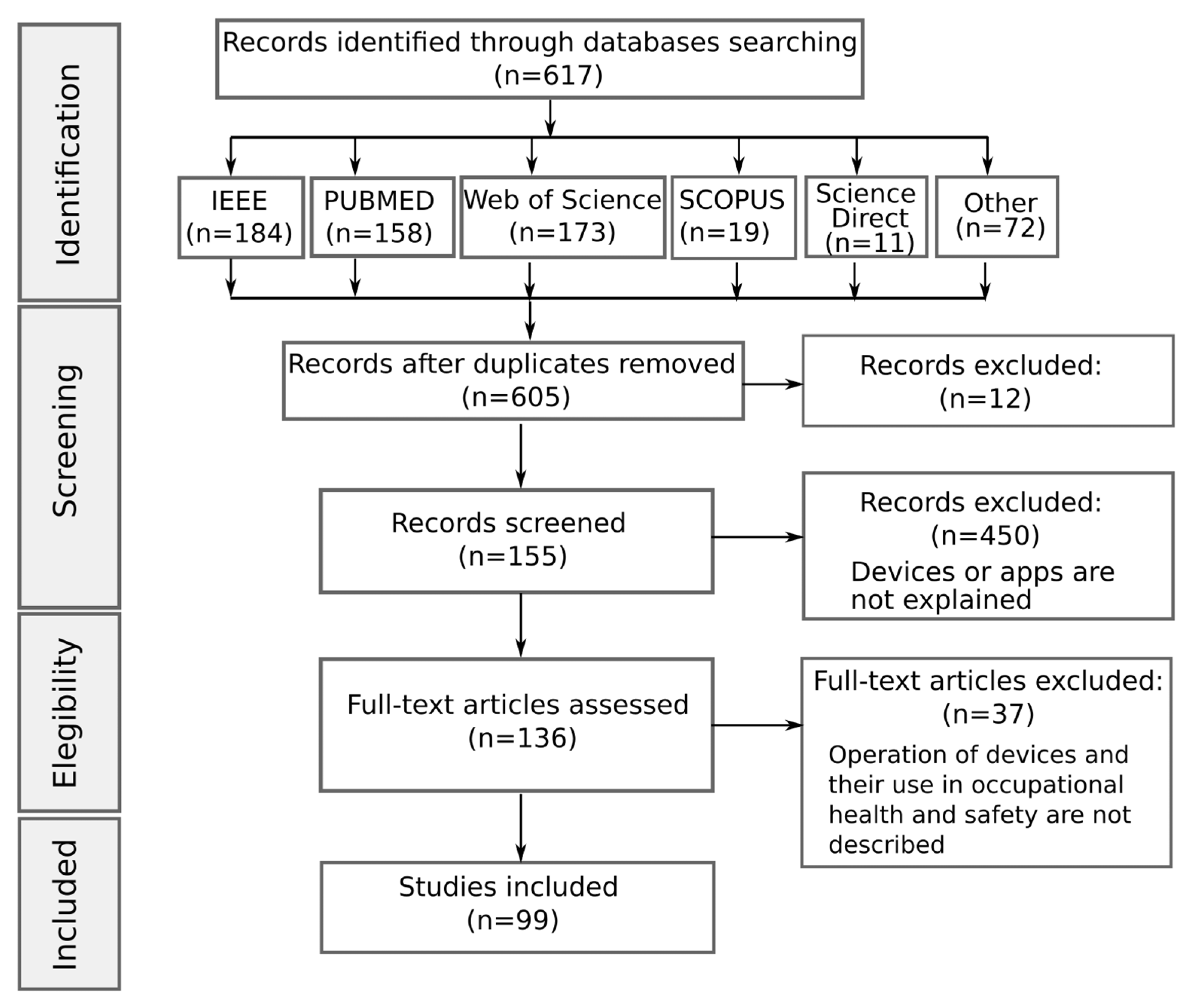
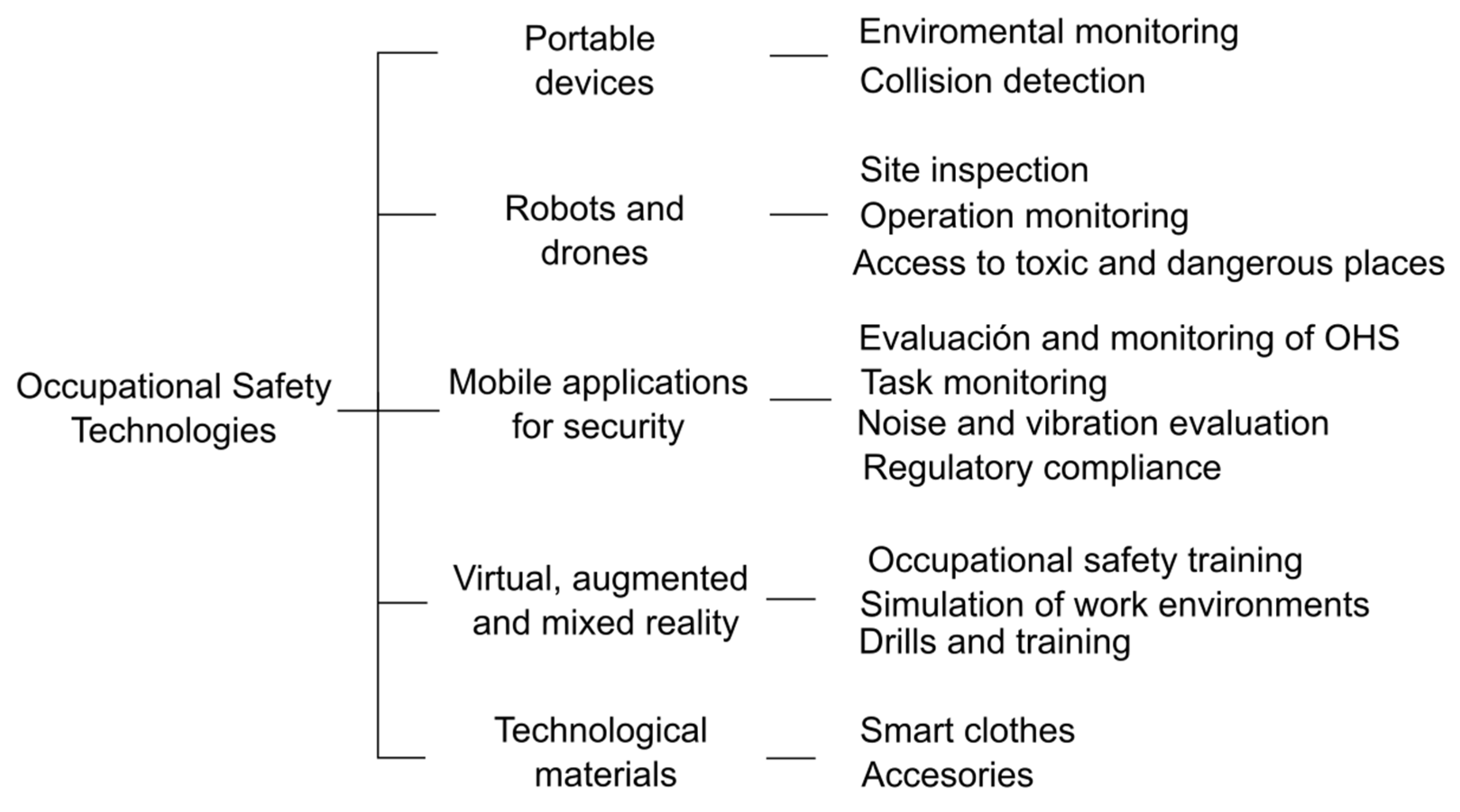
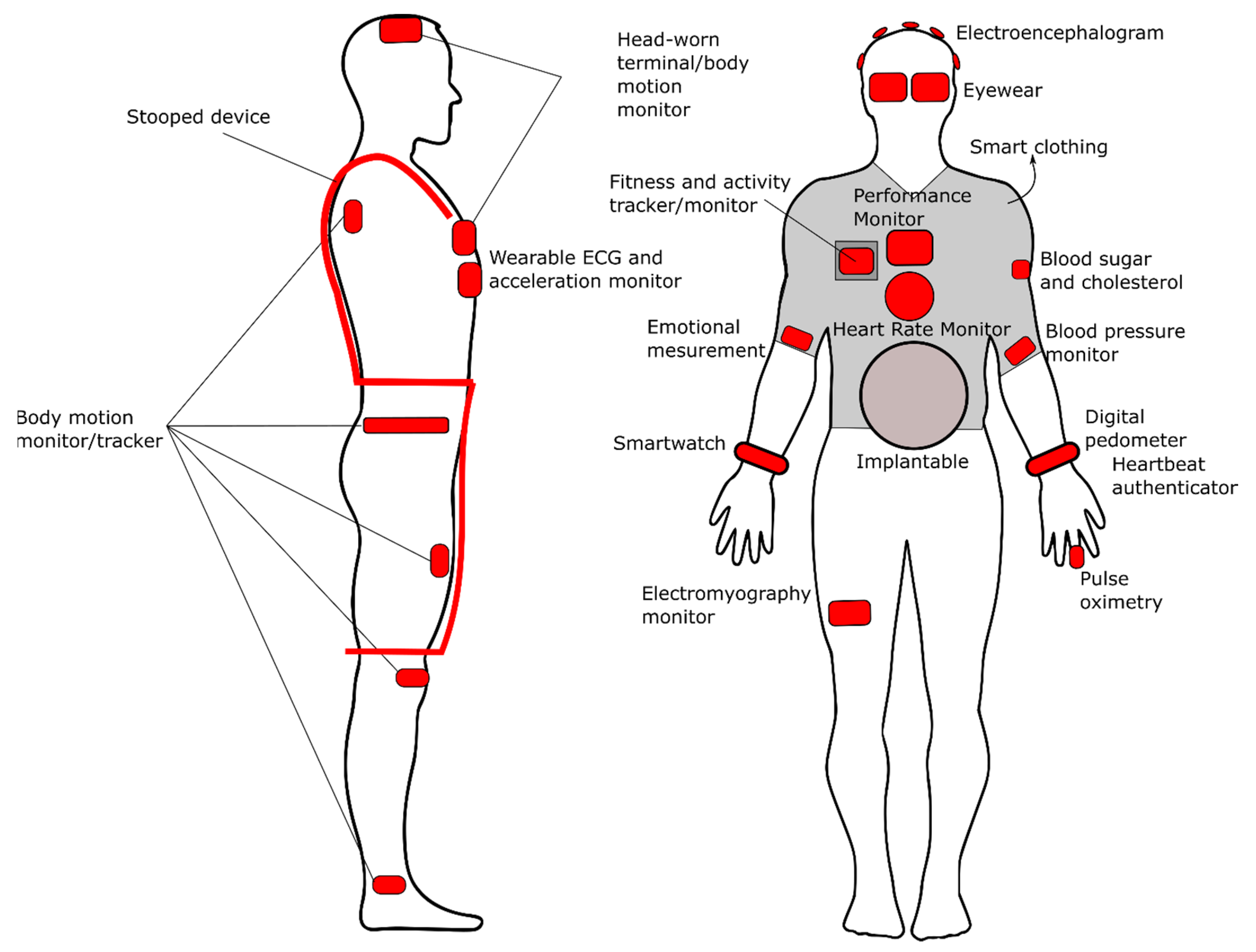
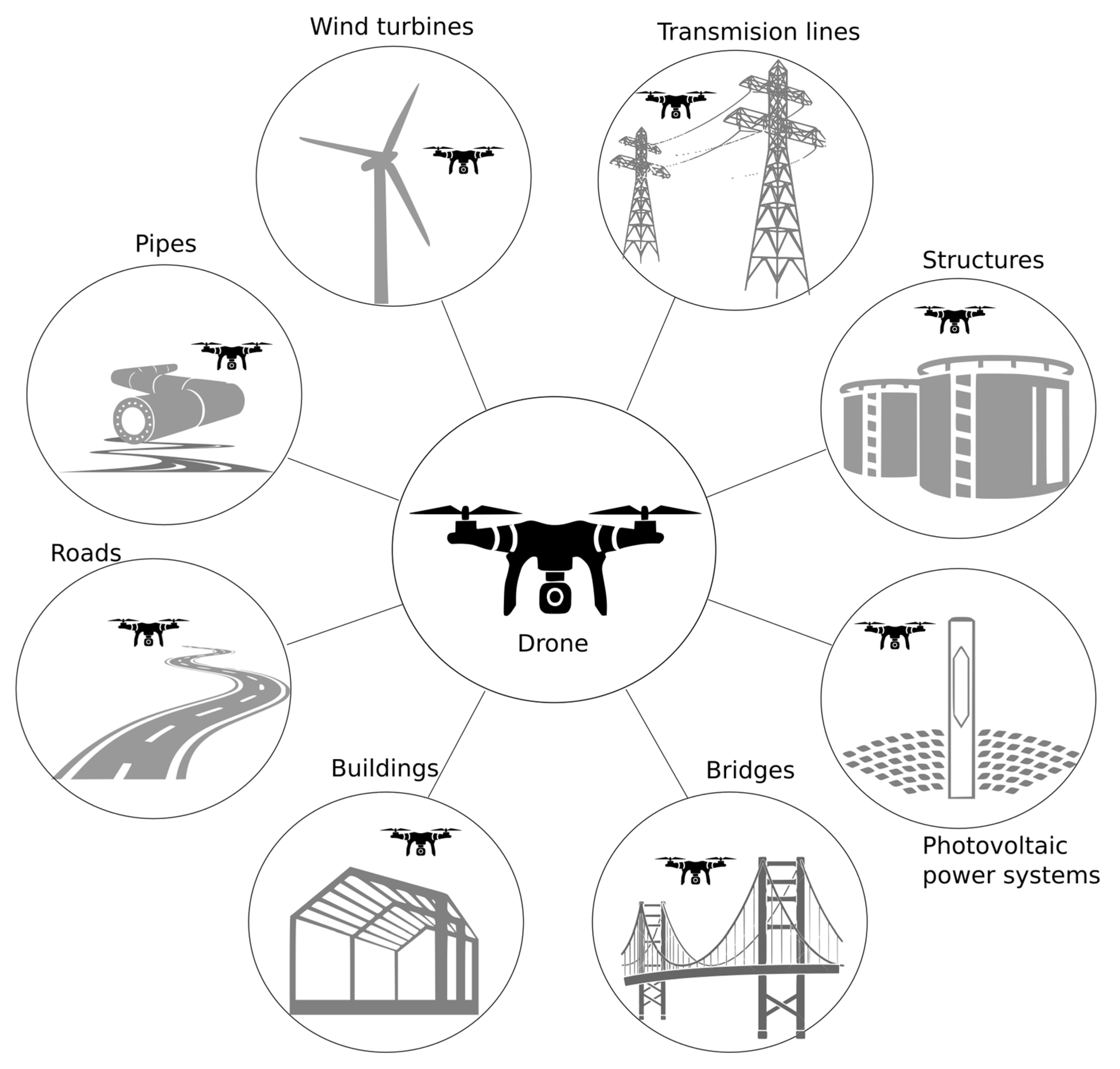
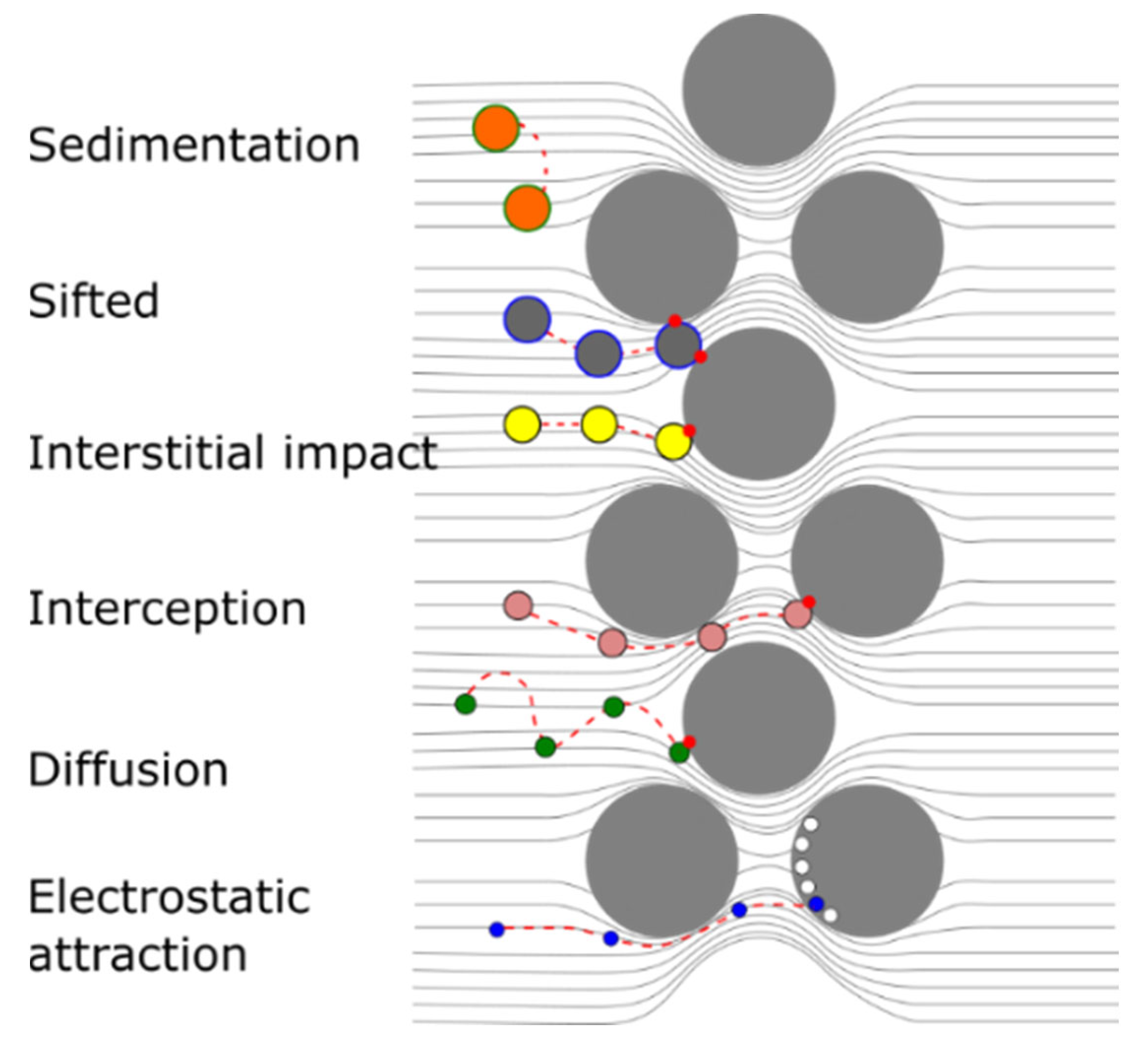
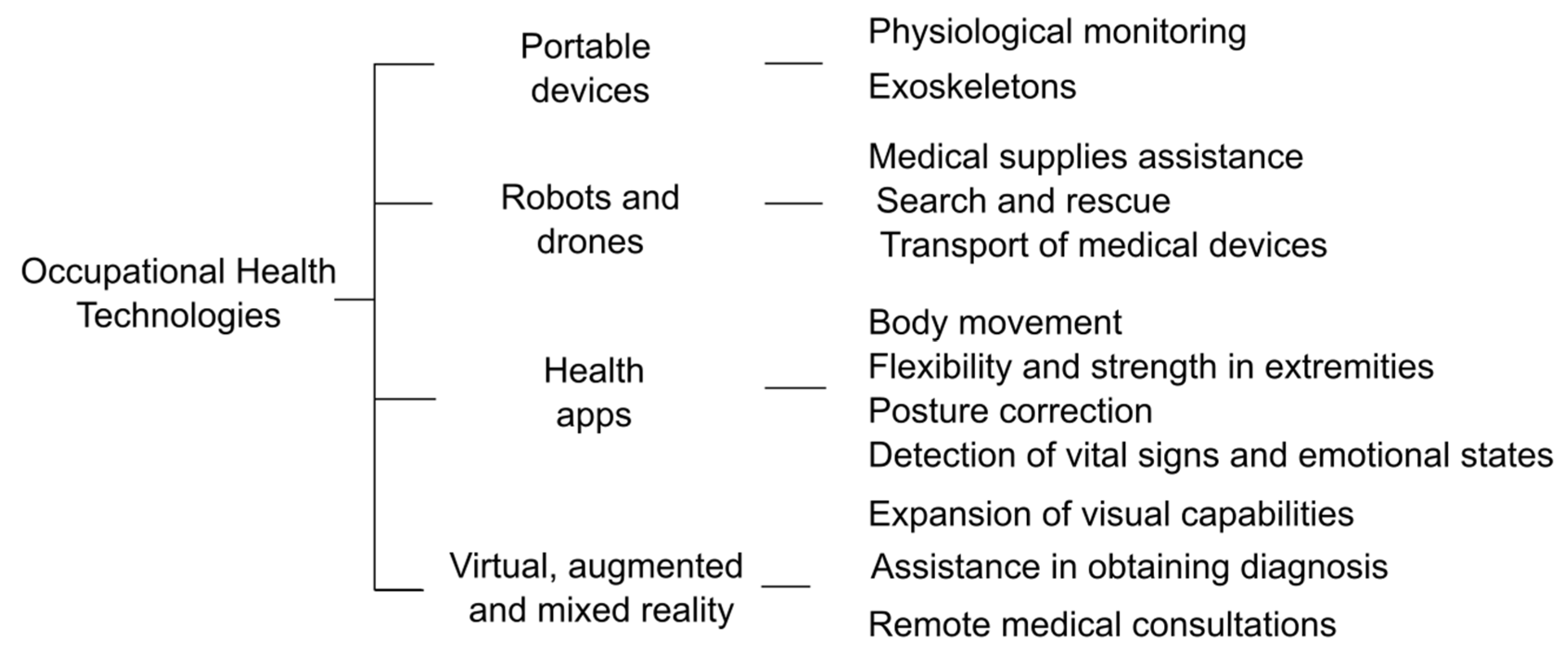


| N° | Quality Assessment Questions | Answer |
|---|---|---|
| QA1 | Does the paper describe devices or technologies for safety and occupational health? | (+1) Yes/(+0) No |
| QA2 | Does the document specify how technology improves working conditions? | (+1) Yes/(+0) No |
| QA3 | Does the paper describe the principles and technical characteristics of the operation of these technologies? | (+1) Yes/(+0) No |
| QA4 | Are the limitations of using these technologies described in the paper? | (+1) Yes/(+0) No |
| QA5 | Is the journal or conference in which the paper was published indexed in SCImago Journal Rank (SJR)? | (+1) if it is ranked Q1, (+0.75) if it is ranked Q2, (+0.50) if it is ranked Q3, (+0.25) if it is ranked Q4, (+0.0) if it is not ranked. |
| Database | String Search | Studies Number |
|---|---|---|
| IEEE | [title: technolog *] AND [title: “occupational safety”] AND [title: “occupational health”] | 184 |
| PubMed | ((“technolog *”[All Fields] AND “occupational safety”[All Fields]) AND “occupational health”[All Fields]) AND ((y_5[Filter]) AND (ffrft[Filter])) | 158 |
| Web of Science | search: technolog * “occupational safety” “occupational health” | 173 |
| Scopus | TITLE (technolog* AND “occupational safety” AND health) | 19 |
| Science Direct | Title, abstract, keywords:technology technologies “occupational safety” “occupational health” | 11 |
| Application | Field | Description | VR Benefits Reported | Year |
|---|---|---|---|---|
| Immersive virtual reality for training and decision making [57] | Chemical | Creation of an accident scenario to test VR-based training for decision making | Improve operator responses time and accuracy of actions | 2014 |
| Virtual reality simulation technology for military and industry skill improvement and training programs [58] | Energy | VR-based training for machinery in oil and gas rigs. | VR was shown to be an effective method of training due to the enhanced sense of scene realism. | 2014 |
| Virtual reality-based pilot training for underground coal miners [59] | Mining | Evaluation of virtual reality training for underground coal mining | Users considered the VR training a helpful program. Miners reported positive effects of the VR training as long as three months after the training session | 2015 |
| Virtual reality simulation for construction safety promotion [60] | Construction | Testing the use of VR to increase construction safety | Demonstrates the development and utilization of a training program based on VR. The training program can offer a safe working environment where users can effectively rehearse tasks with electrical equipment common in the construction industry. | 2015 |
| A social virtual reality-based construction safety education system for experiential learning [61] | Construction | A VR environment was used as an educational way to train in safety in construction work | VR platforms showing social/collaborative situations can improve construction safety as well as health education. | 2015 |
| Operator training simulator for biodiesel synthesis from waste cooking oil [62] | Chemical | Testing a training scenario for the process of homogeneously catalyzed biodiesel production. Various malfunctions were included in the scenario. | A complex scenario where realistic malfunctions are included. It can be beneficial for training operators, enhancing the learning curve. | 2016 |
| Virtual reality-based application for safety training at shipyards [63] | Nautic | This development simulates immersive training using portable fire extinguishers, fire drills, and confined space hazard observation. | The result showed that safety training used in virtual reality could improve knowledge of occupational safety theory by 14.05%. | 2022 |
| An evaluation of virtual reality for fear arousal safety training in the construction industry [64] | Construction | Provision of safety training focusing on job site simulation for hazard identification, demonstration of safety practices, and knowledge-based safety testing. | It was demonstrated empirically that training in safety and situations with the excitement of fear in VR improve the safety attitudes of construction workers, subcontractors, and employees. | 2021 |
| Incorporating virtual reality technology in safety training solutions for construction sites of urban cities [65] | Construction | Immersive and interactive training platforms based on multiplayer mode and incorporating virtual reality (VR) technology to improve workers’ safety awareness. The developed simulation platform is a training solution providing repeatable and flexible procedures within a secure environment. | Results indicate that workers were better trained under the developed immersive environment and could memorize critical points more effectively because VR technology can allow people to experience dangerous situations without being physically injured, thus creating a safer and more efficient training environment. | 2020 |
Disclaimer/Publisher’s Note: The statements, opinions and data contained in all publications are solely those of the individual author(s) and contributor(s) and not of MDPI and/or the editor(s). MDPI and/or the editor(s) disclaim responsibility for any injury to people or property resulting from any ideas, methods, instructions or products referred to in the content. |
© 2023 by the authors. Licensee MDPI, Basel, Switzerland. This article is an open access article distributed under the terms and conditions of the Creative Commons Attribution (CC BY) license (https://creativecommons.org/licenses/by/4.0/).
Share and Cite
Flor-Unda, O.; Fuentes, M.; Dávila, D.; Rivera, M.; Llano, G.; Izurieta, C.; Acosta-Vargas, P. Innovative Technologies for Occupational Health and Safety: A Scoping Review. Safety 2023, 9, 35. https://doi.org/10.3390/safety9020035
Flor-Unda O, Fuentes M, Dávila D, Rivera M, Llano G, Izurieta C, Acosta-Vargas P. Innovative Technologies for Occupational Health and Safety: A Scoping Review. Safety. 2023; 9(2):35. https://doi.org/10.3390/safety9020035
Chicago/Turabian StyleFlor-Unda, Omar, Mauricio Fuentes, Daniel Dávila, Mario Rivera, Gladys Llano, Carlos Izurieta, and Patricia Acosta-Vargas. 2023. "Innovative Technologies for Occupational Health and Safety: A Scoping Review" Safety 9, no. 2: 35. https://doi.org/10.3390/safety9020035
APA StyleFlor-Unda, O., Fuentes, M., Dávila, D., Rivera, M., Llano, G., Izurieta, C., & Acosta-Vargas, P. (2023). Innovative Technologies for Occupational Health and Safety: A Scoping Review. Safety, 9(2), 35. https://doi.org/10.3390/safety9020035








